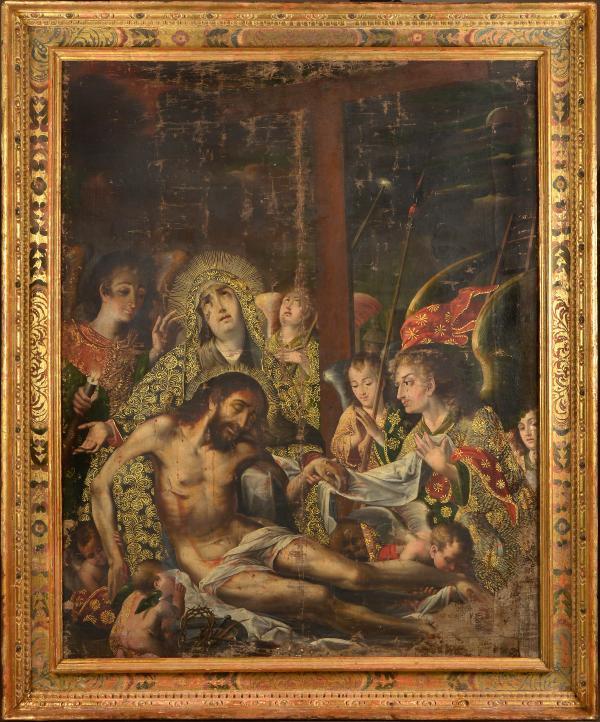Exhibition Organization
The early modern era (c. 1500-1800) was a period marked by imperial expansionism, conquest, and colonization. Cataclysmic social and geopolitical shifts brought people into closer contact than ever before—in real and imagined ways propelling the creative refashioning of the material culture that surrounded them. The central, overarching subject of this exhibition-which reflects the impetus behind the formation of the collection—is the interconnectedness of cultures and ideas in the early modern world. The exhibition is organized in five thematic sections that speak to this prevailing notion.
Eyes of the Imagination: Envisioning the Divine. After the Spanish conquest, devotional images became essential to evangelize the Indigenous population and instruct in matters of the Catholic faith. While European artists initially supplied images, soon local practitioners from different backgrounds produced devotional works to fulfill the growing demand. Paintings were routinely commissioned for altarpieces (retablos) and monastic cycles. The church played an important role in spreading particular subjects, but artists retained significant agency, often grounding their compositions in local histories.
Intimate Faiths. Faith in Spanish America was both public and profoundly personal. Some images demanded close scrutiny to instruct, serve as mnemonic tools, and awaken pious feelings-their small size helping to draw the faithful in. At the outset of evangelization, Indigenous artists incorporated ancient materials and techniques to create new Christian objects and assert their own place within the new body politic, as exemplified by the famous 16th-century Mexican "Hearst Chalice." Intimate devotional paintings and sculptures were kept in private domestic chapels (oratorios) and treasured by the faithful, reflecting their affection for particular saints and wonder working images, while finely rendered badges worn by nuns and friars were pinned to their vestments for all to see, carrying pointed personal and political messages.
Fashioning Identity. This section includes costumes, paintings, and books that demonstrate how dress could powerfully assert social and ethnic differences. For example, clothing is an essential feature of 18th-century Mexican casta (caste) paintings, which depict figures of different races and their children. Since skin color was not a reliable marker, dress-among other elements-reinforced socioracial differences and people's place within the social order. In portraiture, clothing played a key role in conveying the idea of wealth and status, allowing sitters to fashion and refashion their identities and project them onto society.
The Art of Two Artists: The Culture of Copies. The tradition of creating replicas (as well as serial production) was integral to the practice of painting in the early modern world. The Sienese polymath Giulio Mancini (1558-1630) noted that a copy was preferable when painted so dexterously that it tricked the viewer, as it then contained the "art of two artists." The works in this section, from the viceroyalty of New Spain (Mexico), offer powerful visual commentary on the creative process of local painters and their engagement with both local and foreign source material.
New World Emporium. By the 16th century, Spanish America became a center of global trade and a major economic and cultural emporium. With the conquest of the Philippines in 1565, Spain established a sophisticated trade system that linked Asia, Europe, and the Americas. The influx of Asian goods in Spanish America satisfied a growing taste among the elite for these luxury items and inspired the creation of new ones, some entrenched in ancient traditions. This confluence of materials, techniques, and styles gave rise to astonishing new commodities in dialogue with the wider world.
Exhibition Highlights. The exhibition includes a range of materials-costumes, paintings, sculptures, and decorative arts. Among the exhibition's highlights are several new acquisitions, including the monumental Pieta by the Potosf painter Melchor Perez Holgufn, which was restored for the exhibition. A video of the painting's restoration will be accessible via the exhibition and on LACMA's website. Other highlights are a series of works employing shells known as enconchados; these include paintings created in the viceroyalty of New Spain (Mexico), and decorative arts produced in Guatemala for export to Mexico and Lima. The designs referenced a broad repertoire of Indigenous, European, and Asian sources, which were creatively synthesized and recombined by local artists.
Exhibition Publication. Archive of the World is accompanied by a major catalogue that represents the first comprehensive study of LACMA's notable holdings of Spanish American art. Exquisitely illustrated with new photography and filled with fresh new scholarship, the book makes the collection more widely known and accessible. Written and edited by Ilona Katzew, the book includes a text about the formation of LACMA's collection and nearly 100 catalogue entries by various scholars. Conceived as short, focused essays, the contributions offer multiple access points to appreciate the material, aesthetic, and historical aspects of the objects. The works' new and authoritative interpretations, enriched by collaboration with LACMA's Conservation Center, provide a lasting reference in this increasingly influential area of art history. The book is published by LACMA and DelMonico Books•D.A.P.
Related Programming
Objects Talk: Transformations in Spanish America Art Bilingual Scholar's Day; September 30-0ctober 1
An international scholar's day will be co-organized with UCLA's Center for 17th- & 18th-Century Studies and the William Andrews Clark Memorial Library, enabling established and emerging scholars to present new research in this rapidly growing and vibrant field. Echoing the overall premise of the exhibition and catalogue, presenters will take a close or "slow" look at individual artworks and the stories they tell from an artistic, historic, and material perspective.
Reading with Pulitzer Prize-Winning Poet Laureate Natasha Trethewey; October 12
In response to the casta paintings in the exhibition, Pulitzer Prize-winning poet Natasha Trethewey will offer a public reading and engage in conversation with two distinguished scholars about the many issues that these provocative paintings elicit in contemporary society.






























